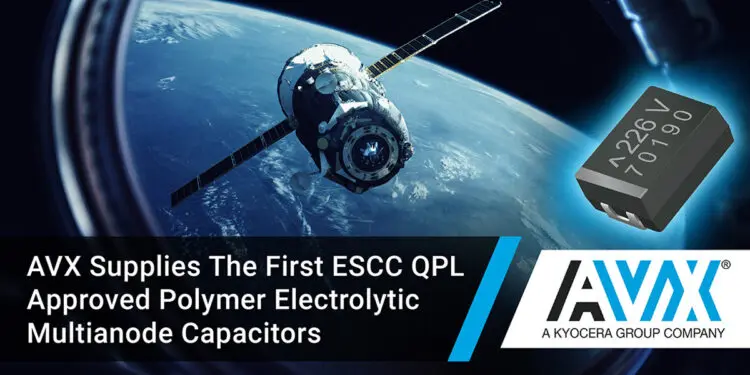The European Space Agency has qualified AVX to supply TCS Series COTS-Plus Ultra-Low-ESR Polymer Electrolytic Multianode Chip Capacitors for use in mission-critical space programs including satellites, missiles, and rovers.
AVX Corporation, a leading manufacturer and supplier of advanced electronic components and interconnect, sensor, control, and antenna solutions, is the first manufacturer qualified to supply polymer electrolytic multianode capacitors for use in European Space Agency (ESA) programs. The company’s well-proven TCS Series COTS-Plus Solid Polymer Electrolytic Multianode Chip Capacitors, which are manufactured at the ESA-qualified AVX Czech Republic facility in Lanskroun, are now listed on the European Space Components Coordination (ESCC) Qualified Parts List (QPL), Detailed Specification 3012/006, as recommended by the Space Components Steering Board.
TCS Series solid polymer electrolytic multianode capacitors approved to the ESCC QPL have a ruggedized multianode construction with three parallel anodes. The E-case (EIA Metric 7343-43) components measure 7.30mm x 4.30mm x 4.10mm (L x W x H ±0.20) and satisfy stringent space and weight requirements for aerospace equipment. Each lot is subjected to statistical screening, accelerated ageing, and comprehensive testing procedures to ensure long lifetime operation in extreme environments with improved base reliability of 0.5% per 1,000 hours.
They exhibit low equivalent series resistance (ESR) with values ranging from 12–50mΩ depending on capacitance and voltage. The capacitance range is 22–470μF with a ±20% capacitance tolerance and a voltage range of 6.3–35VDC for operating temperatures extending from -55°C to +105°C. Customers can also choose testing levels B or C and request one of three lot acceptance testing (LAT) procedures per ESCC regulations to ensure suitable reliability for various space, avionics, military, industrial, and telecommunications applications.
“AVX has a long history of designing and developing ruggedized, ultra-high-reliability electronic components for mission-critical space applications and is extremely proud to offer the industry’s very first polymer electrolytic multianode capacitors approved for use in European space programs including satellites, missiles, and rovers,” said Chris Reynolds, tantalum technical marketing manager, AVX. “AVX Lanskroun is also ESA qualified to supply TAJ Series single-anode tantalum capacitors per ESCC QPL 3012/001 and TES Series multianode tantalum capacitors per ESCC QPL 3012/004.”
The ESCC QPL approved TCS Series multianode polymer capacitors are supplied in bulk packaging but can be packaged on tape and reel packaging for automated processing upon request. Lead-time for the series depends on customer test specification requirements.































